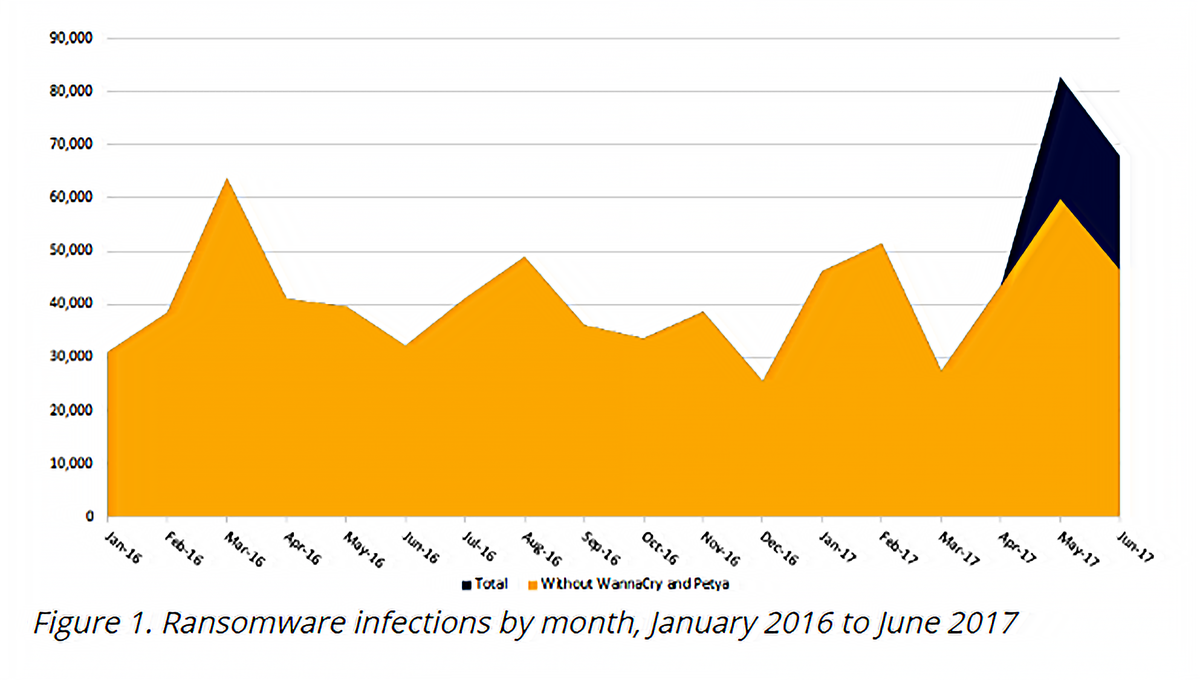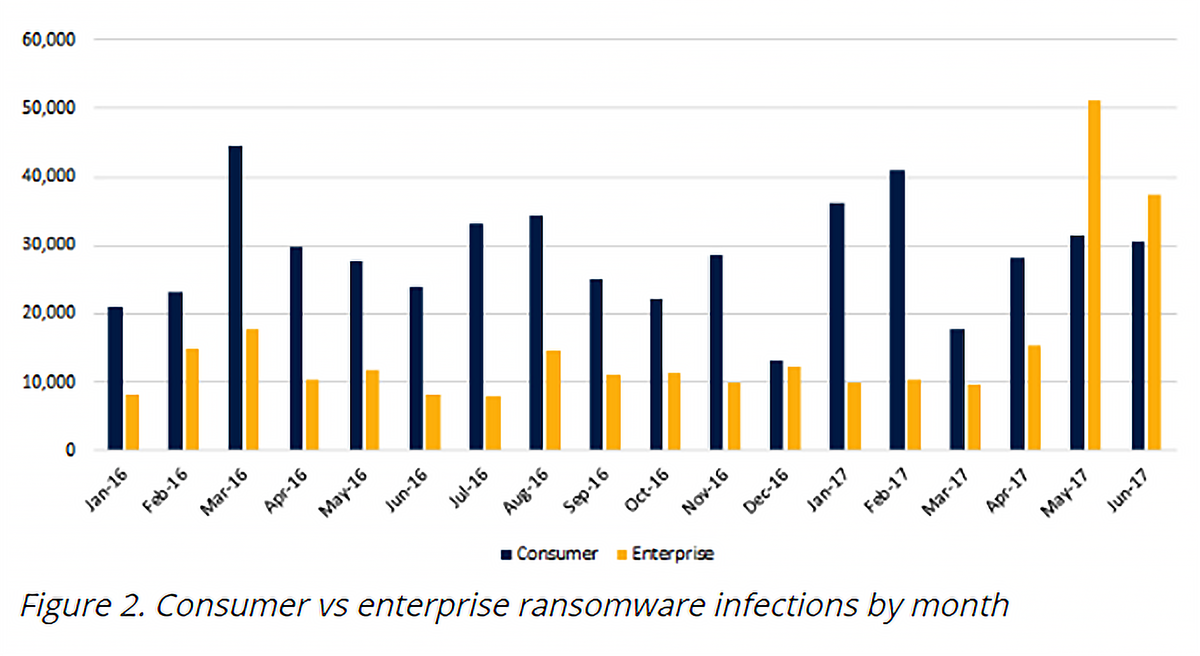While ransomware has long been one of the main cyber threats to businesses, the past number of months have seen organizations more exposed than ever. Symantec’s latest research paper on ransomware has found that businesses were the main victims of the WannaCry and Petya outbreaks, with corporate networks the ideal breeding ground for this new generation of self-propagating threats.
Our research found that overall ransomware infection numbers have continued to trend upwards. During the first six months of 2017, Symantec blocked just over 319,000 ransomware infections. If this infection rate continued for the full year, 2017 would be a significant increase over 2016, when a total of 470,000 infections were blocked. Contributing to this increase was a spike in blocked infections during May and June 2017, the months when the WannaCry and Petya outbreaks occurred.
 Figure 1. Ransomware infections by month, January 2016 to June 2017
Figure 1. Ransomware infections by month, January 2016 to June 2017
WannaCry and Petya: New threats emerge
This year saw the arrival of a new generation of self-propagating ransomware. WannaCry, which was the first to appear, caused global panic due to its ability to spread itself across the networks of infected organizations and then spread to other organizations across the internet. Petya mimicked some of the techniques employed by WannaCry to spread itself across networks.
What enabled WannaCry to spread so quickly was that its developers had incorporated the leaked “EternalBlue” exploit into its code. An exploit of a vulnerability in the Windows implementation of the Server Message Block (SMB) protocol (CVE-2017-0144), it had been patched two months earlier, but there were still enough unpatched computers online for WannaCry to spread quickly. EternalBlue allowed WannaCry to act like a worm, spreading itself to other unpatched computers on the local network and across the internet by scanning random IP addresses in an attempt to find other vulnerable computers.
Six weeks later, a new variant of Petya adopted similar tactics, using EternalBlue as a propagation mechanism, but also incorporating other SMB network spreading techniques, which meant it could spread within organizations to computers that had been patched against EternalBlue. Another difference from WannaCry was that Petya was far more targeted, configured to mainly affect organizations in Ukraine, although other organizations in other countries were also affected.
Organizations in the crosshairs
The impact of WannaCry and Petya makes it quite likely that more attackers will attempt to replicate the tactics used by deploying ransomware as a worm. The propagation mechanisms employed by both ransomware families enabled the threats to spread quickly across an entire computer network. Many consumer computers are not connected to a network, unlike those found in organizations.
While WannaCry and Petya also did have the ability to spread across the internet to other vulnerable computers, this means of transmission again largely affected other organizations. Most home internet routers would have blocked infection attempts involving the EternalBlue exploit.
WannaCry and Petya’s disproportionate impact on organizations can be seen in infection statistics. During 2015 and 2016, businesses accounted for between 29 and 30 percent of ransomware infections. That figure shot up to 42 percent in the first half of 2017, with a major spike in business infections during May and June, the months WannaCry and Petya spread.
 Figure 2. Consumer vs enterprise ransomware infections by month
Figure 2. Consumer vs enterprise ransomware infections by month
Organizations need to prepare themselves for the threat posed by self-propagating ransomware. The Petya outbreak demonstrated that even without EternalBlue, attackers can create worm-like ransomware that is capable of spreading across a network. While it does require more skill and the use of additional tools, such as credential stealers, the potential rewards are much greater.
Ransom demands stabilize
During the first six months of 2017, the average ransom demand seen in new ransomware families was US$544. This follows on from a period of rapid inflation in ransom demands. During 2016, the average ransom demand seen in new ransomware families increased dramatically, rising more than threefold from $294 to $1,077.
 Figure 3. Average ransom amount in U.S. dollars, by year
Figure 3. Average ransom amount in U.S. dollars, by year
This could suggest that after a period of trial-and-error in 2016, many attackers have settled on a ransom demand of around $500 as the “sweet spot” for ransom demands. While this may not sound like a major loss for an organization, most ransom demands are for a single infected computer. If an organization finds itself with tens or hundreds of infected computers, the price demanded by attackers will quickly add up.
Now is the time to bolster defenses
WannaCry and Petya proved that ransomware is not a predictable threat and organizations who are complacent may be caught out. Building a multi-layered defense ensures that any point of failure is mitigated by other defensive practices.
This should include not only regularly patching vulnerabilities and ensuring critical systems are backed up, but also employing multiple, overlapping, and mutually supportive defensive systems to guard against single-point failures in any specific technology or protection method.
Tips for businesses and consumers
- New ransomware variants appear on a regular basis. Always keep your security software up to date to protect yourself against them.
- Keep your operating system and other software updated. Software updates will frequently include patches for newly discovered security vulnerabilities that could be exploited by ransomware attackers, such as EternalBlue.
- Email is one of the main infection methods. Delete any suspicious-looking email you receive, especially if they contain links and/or attachments.
- Be extremely wary of any Microsoft Office email attachment that advises you to enable macros to view its content. Unless you are absolutely sure that this is a genuine email from a trusted source, do not enable macros and instead immediately delete the email.
- Backing up important data is the single most effective way of combating ransomware infection. Attackers have leverage over their victims by encrypting valuable files and leaving them inaccessible. If the victim has backup copies, they can restore their files once the infection has been cleaned up.
Protection
Adopting a multi-layered approach to security minimizes the chance of infection. Symantec has a comprehensive strategy that protects against ransomware in three stages.
- Prevent: Email security, Intrusion Prevention, Download Insight, Browser Protection, Proactive Exploit Protection (PEP).
- Contain: Advanced signature-based antivirus engine with machine learning heuristic technologies, including SONAR and Sapient.
- Respond: Dedicated Incident Response team to help organizations respond and recover from a ransomware attack.
Find out more
For an in-depth look at the threat posed by ransomware and to learn more about Symantec’s ransomware protection strategy please see our whitepaper: Ransomware 2017: An ISTR special report
